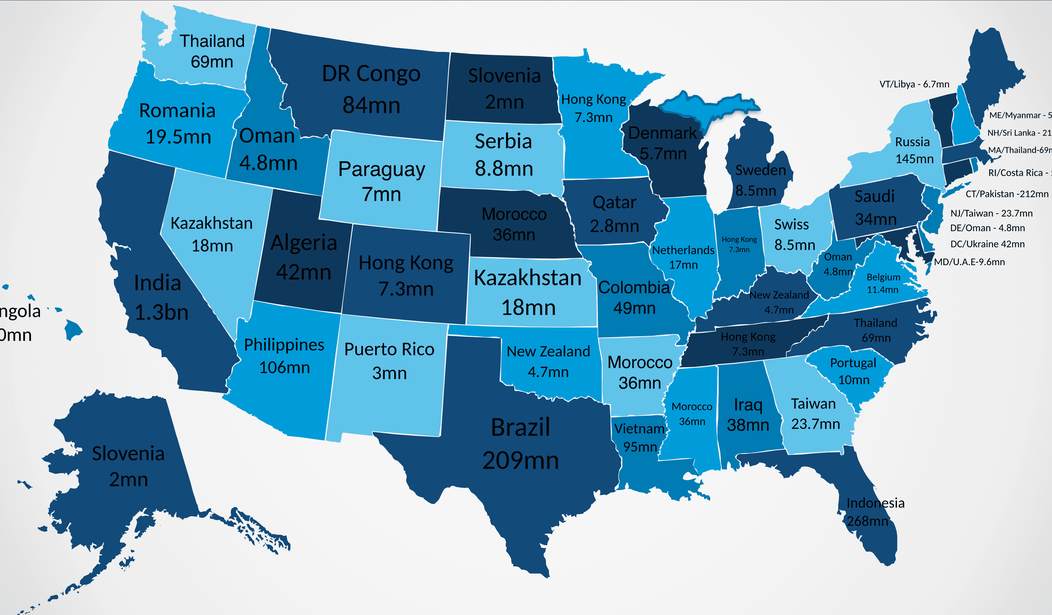A couple of years back, AEI’s Mark J. Perry put together a cool map renaming all 50 of our United States, if each one of them was an actual country of equivalent wealth (or GDP). Being the map freak Longtime Sharp VodkaPundit Readers™ know me to be, someone brought Perry’s map to my attention a few weeks ago, and I immediately fell in love with it.
Here it is, but I have to warn you: It only tells a small part of the story I’m going to tell you today.

As that sharp commenter said to me, the United States economy is like an entire world unto itself. China is a similar case to ours, a huge outlier in terms of wealth produced. And yet if you measure productivity, China doesn’t measure up. China’s GDP is almost exactly one-third smaller than ours, but their population is four times larger. But let’s get back to our project, shall we?
Perry’s data is a bit out of date, and the rankings have changed just enough since 2017 to make for a few significant differences. But where this idea really becomes mind-blowing is when you add in the population figures for each country.
So that’s what I did. I updated Perry’s map with data from 2019, but then I also added the population figure from each country. For example, South Dakota has about the same GDP as Serbia, so I labeled our northern plains state “Serbia” — and added “8.8mn” below the name to indicate Serbia’s 8.8 million inhabitants. And yet… South Dakota’s population is only 886,000, or one-tenth of Serbia’s.
Some of the figures might shock you with how out of proportion American productivity is — the source of all wealth — with the rest of the world. In other cases, the sameness between an American state and a foreign country is enlightening, as well.
Take look:
Each state has the name of its GDP-equivalent country, plus the population figure for that country. Whenever possible, I rounded up to the nearest country, so the disparity is often larger than it appears.
If I’ve done my math right — and I have — it means that if America were really all these countries, we’d have a population of 3.3 billion people. Instead, we have almost exactly one-tenth that many, yet still produce a quarter of the world’s wealth. Pat yourself on the back, America: You’ve earned it.
Yet not even that is the full story, which we’ll find in the details.
The one detail that stands right out and grabs your eyeballs is California-as-India. California, home to 39 million people, has a GDP right in line with India, home to over 1.3 billion. That means your average Californian produces about the same amount of wealth each year as 34 Indians. To give you a little more perspective, California — notoriously, if you ask me — is also home to about 30% of America’s welfare cases. If that state were better run, if it weren’t waging political war on its own middle class, the figures versus India would be even more lopsided in California’s favor. It’s just remarkable.
Nevada and Kazakhstan make an even more interesting case, because they share much more in common than the random chance of having a similar GDP. Both nations are landlocked, are mostly arid to semi-arid, and dependent on lakes and rivers that don’t always run in the most convenient directions. And yet Nevada’s three million residents are slightly more productive than Kazakhstan’s 18 million citizens.
You could make the case that Denmark and Wisconsin are both culturally mostly Scandinavian states. Both produced about $345 billion dollars worth of wealth last year, and both are home to about 5.7 million or so souls. A Scandinavian economist is supposed to have said to Milton Friedman many years ago, “In Scandinavia, we have no poverty.” And Friedman said, “That’s interesting, because in America among Scandinavians, we have no poverty either.” Culture (and its resulting behaviors and attitudes) is the trump card for success, and my little map confirms what Friedman noted way back when.
Half of New York’s 19.4 million people are crowded into a single metro area, and the other half into a not-very big state. Together, they produce about as much wealth as Russia’s 145 million, spread out across a quarter of Europe’s most fertile lands, and all of the mineral-rich stretches of Northern Asia. And New Yorkers aren’t even allowed to drill for oil.
Florida and Indonesia both enjoy lovely weather, (mostly) non-threatening neighbors, and mile after mile of amazing coastline. And both places can boast of a rich multicultural heritage. But by 12-to-1, Florida’s flip-flop wearing denizens are just damn better at getting stuff done. You do have to wonder though: Does Indonesia have Java Man stories the away America has Florida Man stories? Asking for a friend.
Also roughly equal in terms of economic performance are Texas and Brazil. Both are energy-rich, draw millions of tourists, and sport world-class beaches. But where Brazil is lush, Texas is more often dry and scrappy. And yet, if Texas had as many people as Brazil, they’d have somewhere around 270 Electoral College votes and control every presidential election. And Democrats wouldn’t even be able to blame it on the Bossa Nova.
Iowa and Qatar have roughly the same population, and roughly the same GDP. Yet one consists mostly of farmland and some rusting industrial areas, and the other is one of the Middle East’s most oil-soaked mini monarchies. What’s that mean? One Middle Easterner has to be born very, very lucky to have as good a life as one Middle American.
“What’s the Matter with Kansas?” was the title of a sneering left-wing screed by Thomas Frank. A better question would be, “What’s the matter with Kazakstan?” since they’re getting their productivity handed to them on a platter by the people of a small state where the most abundant resource is individual grit.
If you think of Switzerland as being one of the richer places in Western Europe, you’d be right. If you think of Ohio as being mostly blue-collar and/or middle class, you’d be right on that score, too. And yet it takes 8.5 million wealthy Swiss to produce as much wealth as 11 million blue-collar and/or middle-class Ohioans — and it isn’t like global elites are spending big bucks every year to “Ski Ohio” the way they do in Switzerland. When you factor in Ohio’s much lower cost of living, the disparities just about equal out. It’s true almost no matter where you go: Their better-off don’t have it any better than our middle class.
Not many people would think to compare Utah and Algeria, which I suppose is one reason people read VodkaPundit. But look at them this way. Both places have lots of arid and inhospitable land, but also gorgeous regions of amazing fertility. Speaking of fertility, both “countries” are dominated by religions that encourage lots of baby-making. But that’s where the similarities end. One place is haunted by ancient Islamic and ethnic rivalries, and the other, well, isn’t. That goes a long way towards explaining why Algeria’s 42 million can’t outcompete Utah’s 3.2 million.
I could tell similar stories of America’s world-beating productivity across all the 50 states, but by now surely you get the idea. So instead I’d like to finish with the one dark cloud on the horizon: Washington, D.C.’s outlandish growth.
The one-time swamp doesn’t actually produce anything, aside from some very nice tourist attractions. They drill no oil in D.C., they write no productivity-enhancing software, they mill no steel, and they manufacture no planes, trains, or automobiles. One of Washington’s primary jobs is to act as a conduit, created and enforced by law, of money taken from people who earned it and then given to people who didn’t — while taking a generous cut along the way.
The only things Washington produces in abundance are the laws and regulations which more often than not impede the productivity of the rest of the nation. As such, it is home to many well-paid bureaucrats. More importantly, it acts as a magnet for many more even better-paid lobbyists. Their job is to make sure that the lawmakers and the rule-givers act in the best interest of the well-connected.
That’s why Washington’s GDP growth has far outpaced the rest of the nation’s since the regulatory explosion that began under Nixon, and accelerated to Ludicrous Speed under Obama. Washington’s per-capita GDP is three times that of middle-of-the-road Ohio. It’s nearly five times greater than last-place Mississippi. And it’s more than double — double! — the next-best figure enjoyed by oil-rich Alaskans (aka Koldwaitis). And it’s all earned from the glorious work of making life more difficult for the Americans who actually produce things. Our productivity might seem like a miracle, but it’s really nothing more than the inevitable result of a culture of liberty protected by the divided powers of federalism. So as Washington has grown, our productivity gains have been shrinking. While that doesn’t mean Kansas is about to become Kazakhstan, it does mean we’re missing out on even more fabulous wealth and growth that we should be enjoying, but aren’t.
If we want to stay on top of the world, we’re going to have to claw back that decision-making power from Washington and return it to our absurdly productive people and states where it belongs.











